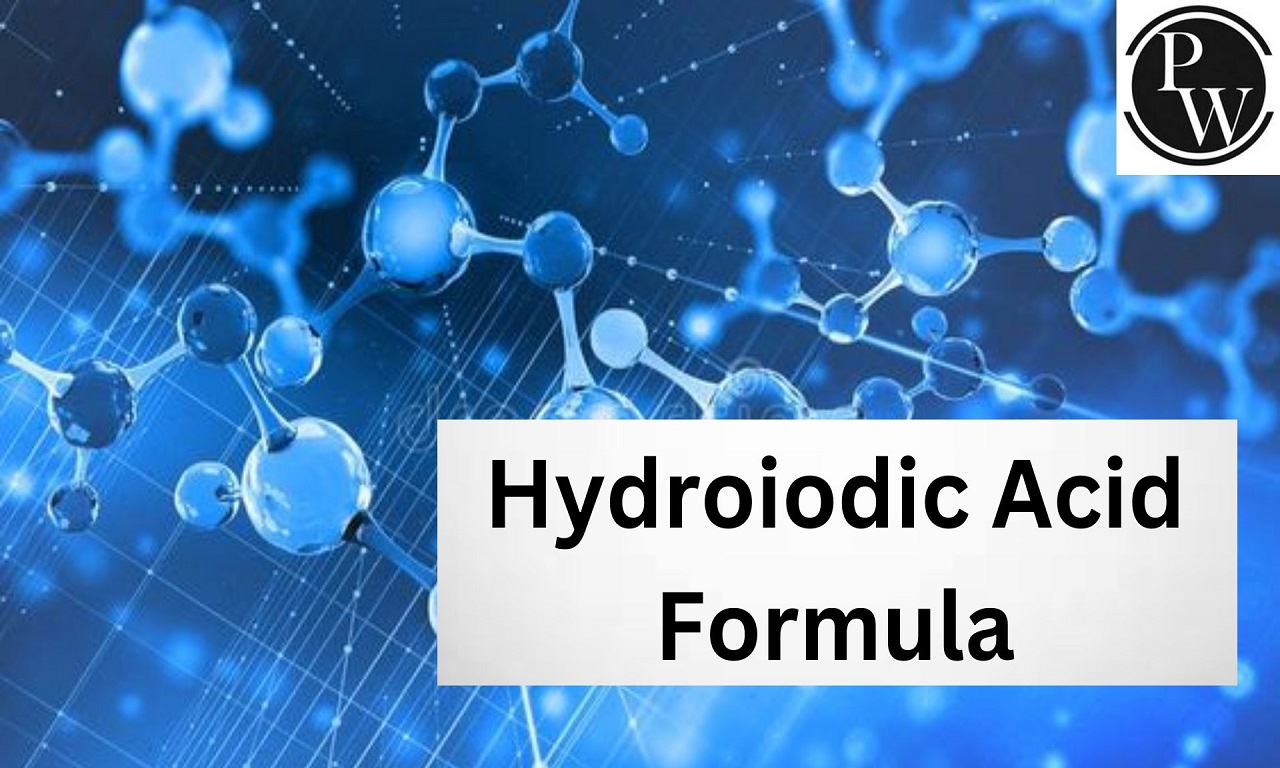

Hydroiodic Acid Formula: Hydroiodic Acid, or HI, is a solution of hydrogen iodide in water. It forms when hydrogen iodide gas dissolves in water. In its dry form, it consists of a single hydrogen atom and a single iodine atom. It's a clear liquid with an unpleasant smell. It has a cooling, salty taste and is odorless. Commercially, it's produced by reacting iodine with hydrazine, resulting in hydrogen iodide and nitrogen gas. its highly stable conjugate base, it's considered one of the strongest common halide acids.
Hydroiodic Acid Formula Name
Hydroiodic Acid, with the chemical formula HI, is named appropriately, and it's used in various applications, including the production of iodides, as a reducing agent, and in disinfectants. It's also a crucial source of iodine in organic and inorganic synthesis and it is used in ketal deprotection alongside potassium iodide.
Hydroiodic Acid Formula Charge
Hydroiodic Acid is represented by the chemical formula HI, which consists of two atoms: a hydrogen atom (H) and an iodine atom (I). Each of these atoms carries a specific charge, and these charges are as follows:
Hydrogen (H) has a charge of +1.
Iodine (I) has a charge of -1.
So, in Hydroiodic Acid (HI), the hydrogen atom has a +1 charge, and the iodine atom has a -1 charge, which balances out to form a neutral compound.
Hydroiodic Acid Formula Structure
The chemical formula for Hydroiodic Acid is HI. Its structure can be described as follows:

Hydroiodic Acid is a diatomic molecule composed of one hydrogen atom (H) covalently bonded to one iodine atom (I). The hydrogen atom and the iodine atom share an electron in the covalent bond. The hydrogen atom is found on one end of the molecule, while the iodine atom is on the other end. This simple linear structure results in a diatomic molecule with a single covalent bond between the two atoms.
Hydroiodic Acid Formula in Aqueous Solution
In an aqueous solution, Hydroiodic Acid (HI) dissociates into its constituent ions due to its acidic nature. When HI is dissolved in water, it forms hydrogen ions (H⁺) and iodide ions (I⁻) as follows:
HI (in solution) → H⁺(aq) + I⁻(aq)
This dissociation results in the release of hydrogen ions (protons) and iodide ions into the aqueous solution, making it acidic.
Hydroiodic Acid Formula Physical Properties
- Molecular Weight: 127.91 g/mol
- Density: 1.700 g/cm³
- Boiling Point: -35.36 °C
- Melting Point: -51 °C
- Odor: Pungent
- Appearance: Colorless Liquid
- Covalently-Bonded Units: 1
- Heat of Vaporization: 17.36 kJ/mol at 25°C
- Hydrogen Bond Donor: 1
- Solubility: Soluble in water
Hydroiodic Acid Formula Chemical Properties
Reaction with Fuming Nitric Acid
Hydroiodic acid reacts with fuming nitric acid to produce iodine, nitrogen oxide, and water.
2HNO 3 + 6HI → 2NO + 3I 2 + 4H 2 O
Reaction with Base (e.g., Sodium Hydroxide)
When hydroiodic acid reacts with a base, like sodium hydroxide, it forms sodium iodide and water.
HI + NaOH → NaI + H 2 O
Uses of Hydroiodic Acid
Hydroiodic Acid finds various uses, such as:
Production of Iodides: It is used in the manufacturing of iodide compounds.
Reducing Agent: Hydroiodic Acid serves as a reducing agent in chemical processes.
Disinfectants: It can be utilized in the formulation of disinfectant products.
Medicinal Applications: Hydroiodic Acid is used in the production of medicines.
Synthesis: It is a crucial source of iodine in both organic and inorganic synthesis.
Ketal Deprotection: When it comes to ketal deprotection, Hydroiodic Acid, alongside potassium iodide, is a suitable choice as a nucleophile source.
Hydroiodic Acid is denoted by the chemical formula HI. It is a compound consisting of a hydrogen atom with a +1 charge (H⁺) and an iodine atom with a -1 charge (I⁻), resulting in a neutral compound. This pungent-smelling acid finds diverse applications in various industries, making it a valuable chemical compound in the field of chemistry and beyond.
| Related Links | |
| Iron (II) Sulfate Formula | Iron (III) Oxide Formula |
| Mercury (II) Nitrate Formula | Lead iv oxide Formula |
Hydroiodic Acid Formula FAQs
What is the chemical formula for Hydroiodic Acid?
How does Hydroiodic Acid appear in its physical state?
What is the structure of Hydroiodic Acid?
What happens when Hydroiodic Acid is dissolved in water?
What are some physical properties of Hydroiodic Acid?












